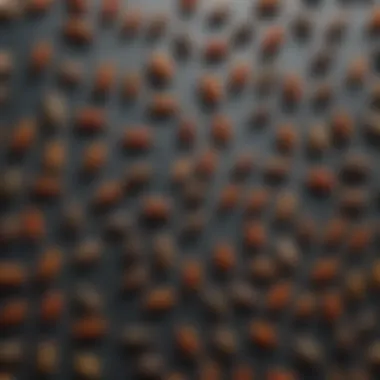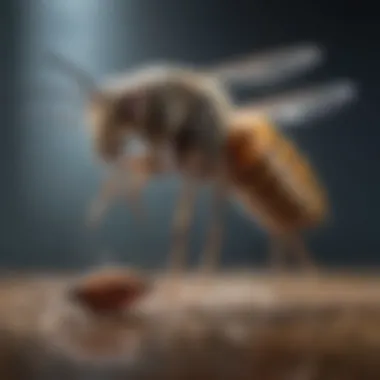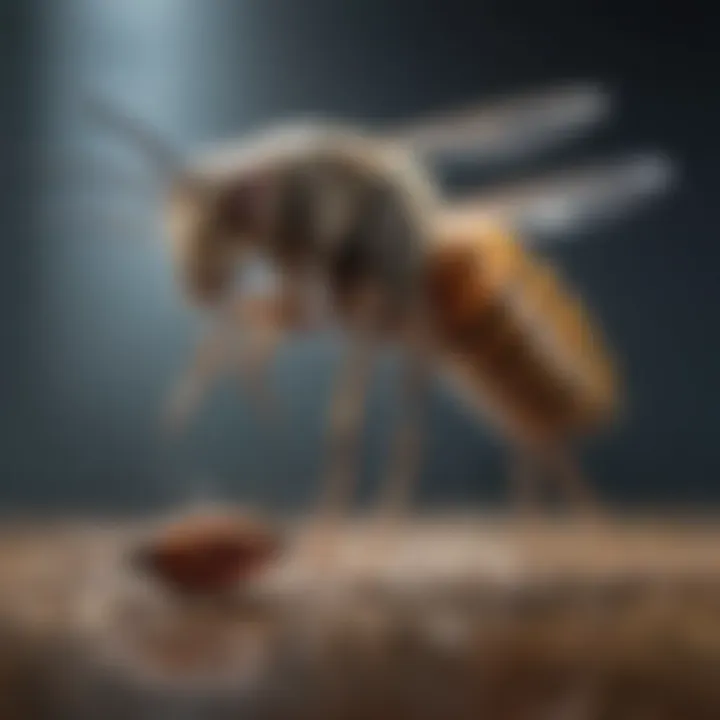Combat Insect Bait: Effective Pest Management Strategies


Intro
The presence of pests in homes and gardens is not just a nuisance but can lead to significant damage and health risks. Effective pest management is essential for maintaining a safe and pleasant living environment. Among the various methods available, combat insect bait offers a strategic approach. This article aims to provide an in-depth analysis of combat insect bait, its effectiveness, application methods, and environmental considerations. By exploring these elements, readers can understand how to better manage pest populations and improve their home environments.
Understanding Pests
Definition of Pests
Pests are organisms that cause harm to human interests. They can be insects, rodents, or other wildlife. Insect pests, such as ants, cockroaches, and termites, frequently invade homes. These organisms reproduce quickly and can lead to structural damage or contamination of food sources. Recognizing what qualifies as a pest is the first step in managing these unwelcome visitors.
Importance of Pest Identification
Identifying the specific type of pest is crucial. This identification informs the choice of control methods, including the selection of appropriate insect baits. Different pests respond to different baits. For instance, a gel bait effective against cockroaches may not work on ants. Understanding the biology and behavior of pests can lead to more effective pest management strategies.
Prevention Techniques
Home and Garden Preventative Measures
Prevention is often the most effective strategy against pests. Homeowners should take steps to minimize opportunities for pests to enter.
- Seal entry points: Close gaps around windows and doors, and repair any holes in walls.
- Proper food storage: Keep food in sealed containers to prevent attracting pests.
- Maintain clean areas: Regularly clean kitchens, dining rooms, and gardens to eliminate potential food sources.
Seasonal Prevention Tips
Different pests may become more prevalent at various times of the year. Understanding these cycles can aid in effective management.
- Spring: Focus on cleaning gardens and removing debris where pests may breed.
- Summer: Check for signs of infestation during warm months when pests are most active.
- Fall: Ensure that all entry points are sealed before the colder months when pests look for warmth.
- Winter: Monitor for rodents as they seek shelter indoors when outside temperatures drop.
Eco-Friendly Pest Control Solutions
Overview of Sustainable Practices
Sustainable pest management relies on minimizing harm to the environment while controlling pest populations. This can involve using baits that are less toxic to non-target species or implementing practices that enhance biodiversity.
Natural Remedies and Their Effectiveness
Homeowners can explore natural remedies as part of their pest control strategy. These methods can often reduce reliance on chemical baits.
For example, diatomaceous earth can effectively control crawling insects by damaging their exoskeletons. Likewise, using plant-based oils like neem oil can repel various pests. However, the effectiveness of these remedies can vary and should be assessed on a case-by-case basis.
Effective pest control requires a balanced approach—combining bait strategies with sustainable practices is vital for long-term success.
In summary, understanding pests, employing preventive techniques, and considering eco-friendly solutions can enhance pest management strategies. These elements together form a comprehensive approach to combating insect infestations.
Prelims to Combat Insect Bait
Understanding combat insect bait is crucial for effectively managing pest populations both in residential and agricultural settings. This section will lay the groundwork for exploring the multifaceted roles that these baits play in pest control. By defining combat insect bait and illustrating its historical evolution, we set the stage for detailed discussions on structure and efficacy that will follow.
Definition and Purpose
Combat insect bait refers to substances formulated to attract and kill specific types of insects. The main aim is to provide a targeted approach to pest control, minimizing broader ecological disruption. Instead of relying on broad-spectrum pesticides, combat insect baits generally use a combination of attractants and toxins designed to lure pests into consuming them. Once ingested, these toxins can lead to mortality or incapacitation of the target insect.
The purpose of these baits transcends simple extermination. They are designed to disrupt the life cycle of pests, reducing their reproduction rates and thereby lowering population numbers over time. This strategy aligns with more sustainable pest management practices that are increasingly vital in today’s ecological discourse. Understanding this dual role can help homeowners select the most effective products for their specific pest problems, ensuring they contribute positively to their environments.
Historical Context
The use of bait systems in pest management is not a recent development. Historically, societies have always sought ways to combat pests that threatened food sources and living conditions. Early methods ranged from mixing natural toxicants with food to attract pests, to the development of more sophisticated formulations in the 20th century.
The modern evolution of combat insect baits began in the mid-20th century when scientists began to understand the intricacies of insect behavior. This knowledge led to the precision we see in formulations today. Baits are now crafted based on the feeding patterns and preferences of specific pests, a significant advancement over earlier, less targeted methods.
As we delve deeper into this article, it will become evident how this historical context informs current practices and innovations in combat insect bait technology. Understanding the past equips us to appreciate the present efficacy and future potential of pest management strategies.
"The ability to learn from historical pest control methods shapes the development of modern solutions crucial for sustainability."
Combat insect baits serve as a vital link in the chain of integrated pest management strategies. Recognizing their importance not only aids in effective pest management but also emphasizes the need for responsible usage that safeguards the environment.
Types of Combat Insect Baits
Understanding the different types of combat insect baits is essential for effective pest management. Each type has unique properties that target specific pests and situations. The effectiveness of pest control measures often hinges on selecting the right formulation. Whether you are a homeowner dealing with a pest issue or a professional in pest management, knowledge of these bait types contributes to informed decision-making and successful outcomes.
Granular Baits
Granular baits are solid formulations often used for outdoor applications. They are particularly effective against ants and cockroaches. This type of bait releases attractants that lure pests. Once consumed, the bait disrupts the pest's ability to function normally. Granular baits generally have a longer shelf life compared to other types. This can make them a practical choice for homeowners who prefer a longer-lasting solution.
However, application requires careful placement to ensure efficacy. Bait is usually scattered in areas where pests are likely to feed. Over-application can lead to wastage and could potentially harm non-target species. Thus, following instructions during the application process is crucial.
When choosing granular baits, consider the specific pests you are addressing. Look for products with active ingredients that effectively target those pests. Using granular baits can be beneficial when dealing with outdoor infestations, especially in yards and gardens, which may be hard to reach by other means.
Liquid Baits
Liquid baits are versatile and can be applied both indoors and outdoors. These formulations typically consist of a liquid carrier mixed with attractants and toxicants. This combination allows quicker uptake by insects, leading to faster knockdown of pests. Liquid baits are particularly useful in targeting ants and termites.
The ease of application is a significant advantage. Homeowners can use bait stations or spot treatments, which often attract pests more efficiently than solid forms. Moreover, liquid baits can be combined with baiting systems that monitor insect activity.
Nonetheless, like granular baits, liquid baits should be used cautiously. Spills might occur, leading to unintended exposure for pets or beneficial insects. It is advisable to follow safety guidelines and manufacturer instructions closely to mitigate these risks. Overall, liquid baits are an excellent option for dynamic pest control needs.
Gel Baits
Gel baits represent a newer technology in pest control, combining ease of use with effectiveness. This type is applied via syringe or tube, making it easy to place in small cracks and crevices. Gel baits are particularly effective against common household pests like cockroaches and ants.
One of the primary benefits of gel baits is the low visibility post-application. This can be essential in aesthetic-sensitive areas, such as kitchens and dining areas. The bait is designed to attract insects, who then share it with other members of their colony, enhancing the overall effectiveness against established populations.
Selecting the right type of insect bait depends on a variety of factors, including the nature of the infestation, location and target pest species. Making informed choices based on these aspects can result in significant improvements in pest management outcomes.
Mechanism of Action
Understanding the mechanism of action for combat insect baits is crucial in effectively managing pest populations. This section explains how these baits function within different pest contexts, highlighting their benefits and potential concerns. Knowing how attractants and toxicants in these baits impact insect behavior will help homeowners and pest control professionals optimize their use.


Attractants and Toxicants
Combat insect baits use specific attractants that lure pests into contact with the toxic agents within the bait. The attractants can be food-based or pheromone induced, depending on the target species. For instance, ants may be drawn to sucrose-based baits, while cockroaches might respond better to protein-based offerings.
The toxicants, normally slow-acting, allow for consumption by multiple pests before significant effects set in. This offers a dual benefit; not only do the baits reduce the population, but they also help in preventing immediate deaths which could signal danger to other pests. This behavior extends the efficacy of the bait, ensuring that the toxicants have the chance to spread back to the nest or colony. Here are some common toxicants used in these baits:
- Boric acid: A widely used insecticide effective against a variety of insects.
- Fipronil: Commonly used in baits targeted for termites and cockroaches.
- Hydramethylnon: Often used for controlling ants.
Recognizing the right combination of attractants and toxicants is key to maximizing efficiency in pest control measures.
Impact on Pest Behavior
The design of combat insect bait takes into account the behavioral responses of target pests. When insects consume the bait, several changes in behavior may occur due to the impact of toxicants. These changes can affect feeding patterns, reproduction and, ultimately, the migration of pests.
For example, many baits induce symptoms that prevent pests from returning to their nests. This will cause them to cease foraging for food. The convulsive effects of some common active ingredients can also impair movement, making it increasingly difficult for pest colonies to sustain themselves. Consequently, this creates a toxic chain reaction as more insects consume the bait and share it within their social groups.
"Understanding the mechanics behind pest behavior and bait composition is essential for effective pest management strategies."
Incorporating knowledge about the behavior of target pests with the appropriate bait strategies results in a more comprehensive pest management plan.
Application Methods
The application methods for combat insect baits play a crucial role in determining their effectiveness against targeted pests. Understanding these methods allows homeowners to select the approach that best fits their specific situations. Choosing the right application method is vital for optimizing bait consumption by pests while minimizing potential risks to non-target organisms.
Indoor Applications
Indoor application of combat insect baits is essential for managing household pests. Effective indoor strategies often involve placing bait in areas where pests are likely to inhabit. This could include corners, cracks, and areas near food sources. Granular and gel baits can be particularly useful indoors due to their targeting abilities and their ease of application.
Points to consider include:
- Placement: Ensure that bait is inconspicuous yet accessible to pests. This minimizes disturbance while maximizing its chance of being found.
- Hygiene: Maintain a clean environment. Pests are less likely to be attracted to bait in clean areas.
- Monitoring: Regularly check bait stations to assess consumption and replace baits as needed.
Outdoor Applications
Applying insect baits outdoors requires careful planning. The outdoor environment presents unique challenges, such as rain and competing food sources. Baits should be placed strategically in shaded or covered areas to prevent dilution or washout from rain.
Key factors to consider include:
- Environmental Conditions: Assess weather forecasts to optimize bait longevity. Avoid applying baits during heavy rain or extreme temperatures.
- Competition: Pests outdoors may have various food sources. Using attractants can help lure pests to the bait.
- Accessibility: Position baits in areas frequented by pests, like near nests or known trails.
Targeted Approaches
Targeted approaches in applying combat insect baits involve customizing the bait placement and formulation according to specific pest behaviors. For example, some baits contain specific attractants that appeal to certain types of insects.
Considerations for targeted applications include:
- Behavioral Patterns: Understanding the habits and life cycles of pests can guide bait selection and placement.
- Formulation: Choose baits that are specially designed for the identified pests, such as ant baits for carpenter ants or roach baits for German cockroaches.
- Integrated Techniques: Sometimes, combining baits with other pest control measures enhances overall efficiency. This could involve sanitation or exclusion practices that can complement bait effectiveness.
"Targeted application approaches tend to yield better results, as they cater specifically to the habits of the pests in question."
Target Pests
Understanding the target pests is a vital aspect of utilizing combat insect bait effectively. Target pests are those specific insect species that the bait aims to eliminate or control within a given environment. This focus is essential because different baits possess unique compositions that cater to particular pests. Knowing how to identify these pests ensures that homeowners and pest management professionals apply the right strategies, optimizing the efficacy of the bait used.
Common Pests Addressed
Several common pests can be managed through the use of combat insect baits. These include ants, roaches, termites, and cockroaches.
- Ants: This species is notorious for invading homes, especially kitchens. Various baits attract ants, receiving positive results through proper usage.
- Cockroaches: Known for their resilience, cockroaches require targeted bait applications. Selecting a bait specifically designed for this pest is paramount to success.
- Termites: These pests can cause extensive damage if left unchecked. Baits targeting termites work effectively to control their populations and safeguard wooden structures.
- Flies: In some cases, flies can also be attracted to combat insect baits, making them an additional target for pest control.
By addressing these pests through effective bait strategies, homeowners can significantly reduce pest populations in and around their properties. For effective results, one must understand the behavior and lifecycle of these pests.
Resistance Patterns
Resistance patterns refer to the ability of certain insects to adapt and survive despite exposure to insecticides, including combat baits. Understanding these patterns is critical for developing effective pest management strategies.
- Behavioral Resistance: Some pests may develop avoidance behaviors, steering clear of bait stations or formulations that they have encountered before.
- Physiological Resistance: This occurs when a pest's biological makeup modifies, allowing it to detoxify the chemicals within the bait.
- Cross-Resistance: If pests are exposed to various types of insecticides over time, they may gain resistance to different chemical classes altogether.
Recognizing these resistance patterns can guide homeowners and pest control professionals in selecting the right baits and adopting alternative strategies, ensuring effective pest management over time. Regular monitoring of pest populations is necessary, as it can reveal emerging resistance trends that may require a change in approach.
Effective pest management is an ongoing process. Homeowners must stay informed on target pests' behaviors and resistance patterns to continually adapt their strategies accordingly.
Efficacy of Combat Insect Baits
The efficacy of combat insect baits is a vital topic discussed in this article, as it determines the overall success of pest management strategies. Effective baits are not merely tools but act as key players in reducing pest populations in various environments, both indoors and outdoors. Understanding the factors that enhance or hinder their effectiveness, alongside a comparison to alternative pest control methods, provides a well-rounded perspective. Homeowners and pest management professionals alike benefit from insights regarding efficacy, which directly influences their pest control decisions.
Factors Affecting Efficacy
Multiple factors influence the efficacy of combat insect baits. These factors can be categorized into environmental conditions, formulation components, and pest behavior.
1. Environmental Conditions:
- Humidity and Temperature: Extreme variations in weather can affect the stability of bait formulations. Higher humidity may encourage mold growth in granular baits, while high temperatures can reduce the effectiveness of liquid baits.
- Placement Location: The area where the bait is applied also plays a role. Baits placed in high-traffic areas must compete with natural food sources, which may influence pest attraction.
2. Formulation Components:
- Attractants and Toxicants: Effective baits contain specific attractants that lure pests. The balance between food sources and the toxic agents is crucial. Suboptimal ratios may either repel pests or cause delays in consumption, reducing overall effectiveness.
- Bait Sophistication: Innovations in formulations, like those found in Advion or MaxForce, enhance attraction and efficiency. Understanding these products can significantly impact pest management strategies.
3. Pest Behavior:
- Feeding Habits: The dietary preferences of various pest species affect how quickly they consume the bait. For instance, some pests may prefer liquid baits, while others are more inclined towards granular formulations.
- Life Cycle Stages: Different life stages of pests react variably to bait. For instance, larvae may not be attracted to the same bait types as adult insects.
A comprehensive understanding of these factors allows for a more strategic approach in pest control plans. Making small adjustments can lead to significant improvements in the performance of combat insect baits.
Comparison to Other Methods
In evaluating the efficacy of combat insect baits, it is essential to compare them with other pest control methods. While physical traps, sprays, and professional extermination services are common alternatives, each has unique strengths and weaknesses.
1. Targeted Control:


- Combat insect baits are designed for particular pest species, thus providing a more focused control strategy. Unlike broad-spectrum insecticides, which may affect non-target organisms, baits minimize collateral damage.
2. Persistence:
- Certain pesticides offer longer residual effects compared to baits. However, baits often lead to quicker population reductions, providing immediate relief for homeowners.
3. User Accessibility:
- Baits tend to be easier for the average homeowner to apply. Unlike sprayer formulations, which often require safety gear, most baits can be placed with minimal risk.
However, baits are not a one-size-fits-all solution. Situations with high pest pressure may demand a combination of methods for effective control.
"Understanding the efficacy of combat insect baits in conjunction with other pest control options can lead to a holistic and successful pest management strategy."
Environmental Considerations
In any discussion regarding pest management, especially when it involves combat insect bait, the environmental considerations are crucial. This section examines the impacts of these baits on both target and non-target organisms, while also exploring more sustainable alternatives. The effective management of pests must harmonize with our commitment to preserving the ecosystem. Therefore, understanding the environmental effects of combat insect baits will help homeowners make informed and responsible choices.
Non-Target Impact
Combat insect baits often target specific pests but can unintentionally affect non-target species. This impact varies depending on the type of bait used and the application method. For example, granular baits can be carried back to the nest by foraging ants, potentially poisoning a larger population. Birds or beneficial insects like bees may also consume these baits inadvertently.
Key Factors of Non-Target Impact:
- Bait Composition: The ingredients in baits can be toxic to various creatures. Knowing these ingredients is essential for minimizing risk.
- Application Location: Where the bait is applied influences who may be affected. Baits used near water sources can lead to runoff and poisoning of aquatic life.
- Timing of Application: Applying bait during certain seasons can heighten the likelihood of affecting non-target species. For instance, springtime applications could coincide with breeding cycles of certain animals.
"Understanding the potential consequences of non-target impact aids in making strategic decisions to protect beneficial organisms."
Reducing non-target impact requires careful handling and application practices. Homeowners should consider utilizing targeted baits, which have been designed to minimize risks to non-target organisms while effectively addressing specific pest problems.
Eco-Friendly Alternatives
As environmental concerns grow, the demand for eco-friendly alternatives to traditional combat insect baits has increased. These alternatives, while effective, aim to reduce harm to non-target species and the ecosystem as a whole. Some viable options include.
- Biological Controls: These involve the use of natural predators to manage pest populations. Introducing beneficial organisms can reduce reliance on chemical baits.
- Botanical Insecticides: Derived from plants, these substances tend to be less harmful. Products like neem oil can deter pests without significant impact on other wildlife.
- Insecticidal Soaps: These soaps disrupt the cell membranes of soft-bodied insects, effectively controlling them without lingering residual effects on other organisms.
- Traps: Non-chemical traps can be used to physically capture pests. Sticky traps, pheromone traps, or even homemade traps can effectively capture insects while posing minimal risk to other wildlife.
Integrated Pest Management Strategies
Integrated Pest Management (IPM) refers to a holistic approach combining different strategies to manage pests effectively. This section emphasizes the significance of combat insect baits within IPM. Given the complex ecosystem in gardens and homes, understanding how these baits fit into a broader strategy is crucial. This method not only addresses current pest populations but also aims to minimize future outbreaks through sustainable practices.
Role of Baits in IPM
Combat insect baits play a vital role in Integrated Pest Management. Their formulation, designed to attract pests, complements other control methods. The baits attract target insects while utilizing specific active ingredients that kill these pests after ingestion. This targeted approach ensures that beneficial insects remain unharmed. Key advantages of including baits in IPM include:
- Targeting Specific Pests: Insect baits are crafted to lure particular pests, which enhances their effectiveness.
- Reduced Chemical Use: By focusing on specific pests, the overall use of chemicals can be minimized, leading to a safer environment.
- Long-Term Solutions: With proper application, baits can help reduce pest populations over time, creating a more balanced ecosystem.
Baits can also serve as a first line of defense, preventing infestations from escalating. Consequently, IPM strategies that incorporate baits facilitate proactive measures, reducing the reliance on broad-spectrum pesticides in the long run.
Combining Baits with Other Methods
Combining insect baits with other pest management techniques can yield superior results. IPM encourages the integration of multiple methods to produce a synergistic effect on pest control. Some effective combinations include:
- Cultural Controls: These involve practices such as maintaining cleanliness and managing waste to reduce pest habitats. For instance, removing food sources and breeding sites makes insect baits more effective, as pests are drawn to the bait instead of alternative food sources.
- Biological Controls: Introducing natural predators or parasites can help keep pest populations under control. When used alongside baits, biological agents can further diminish pest numbers.
- Mechanical Controls: Physical barriers or traps can work well in tandem with baits. For instance, placing traps near bait stations can increase the chances of capturing pests before they access multiple areas.
By integrating these methods, homeowners can enhance the overall effectiveness of pest management strategies. It is essential to constantly evaluate the local pest populations and adjust tactics accordingly to maintain an efficient system.
"An effective IPM strategy does not rely solely on one method; instead, it combines multiple approaches to achieve sustainable pest management."
Regulatory and Safety Standards
Understanding the regulatory and safety standards surrounding combat insect baits is crucial for both consumers and pest management professionals. These guidelines ensure that the products used are both effective and safe for humans, pets, and the environment. When using insect baits, compliance with these standards not only provides peace of mind but also maximizes the efficacy of pest control efforts.
Regulatory standards typically establish criteria for product formulation, labeling, and usage instructions. They inform the consumer about the active ingredients, application rates, and any potential hazards associated with the product. Most importantly, understanding these standards can reduce the risk of accidental poisoning, which is a serious consideration when handling pest control products.
Moreover, safety measures include specific instructions on how to store, use, and dispose of these baits. This knowledge protects both the user and the surroundings. Recognizing the potential impact on non-target organisms is also vital. A well-informed application strategy helps ensure minimal disruption to beneficial insects and wildlife.
EPA Guidelines
The Environmental Protection Agency (EPA) plays a fundamental role in regulating insect baits in the United States. They evaluate the safety and effectiveness of these products before they can be sold to the public. The guidelines issued by the EPA serve to ensure that all insect baits meet stringent safety criteria. This includes assessments of the ingredients used, their potential effects on human health, and environmental impact studies.
For consumers, these guidelines provide essential information about:
- The active ingredients that are contained within the bait, helping individuals to make informed decisions.
- Any warnings or precautions that must be followed when using the product.
- The application instructions including how much to use and where to apply it.
Following EPA guidelines is a way for homeowners to protect themselves and their families. It helps individuals ensure the baits they use adhere to legal and safety standards that prevent harmful side effects.
Consumer Safety Measures
Safety is a priority when selecting and applying combat insect baits. Consumers should be well-informed to minimize risks associated with pest control products. Essential safety measures include:
- Reading the label: Always review the instructions on the product label. This provides vital information on safe application and emergency procedures in case of accidental exposure.
- Using protective gear: When applying baits, it is advisable to wear gloves and masks if instructed. This can reduce the possibility of direct contact with the skin.
- Storing products safely: Insect baits should be stored out of reach of children and pets to prevent accidental ingestion. Proper storage also preserves the efficacy of the product over time.
- Disposing responsibly: Follow local guidelines for disposal of pest control products. Improper disposal can lead to environmental contamination, posing risks to water sources and wildlife.
Emphasizing safety in pest management practices prevents health risks and promotes responsible use of combat insect baits.
By adhering to established safety standards and guidelines, homeowners can effectively manage pests while ensuring the safety of their household and the broader environment.
Expert Recommendations
The recommendations provided by experts in the field of pest management play a critical role in guiding homeowners and professionals alike in the effective use of combat insect bait. These recommendations provide a foundation of knowledge that enhances the efficacy of baits, ensures safety, and optimizes management strategies.
Understanding the specific needs and behaviors of target pests is paramount. For instance, selecting the appropriate bait type can significantly increase the chances of successful pest eradication. Experts often emphasize the necessity of conducting a comprehensive inspection before applying any insect bait. Knowledge of the pest’s lifecycle, food preferences, and nesting habits can inform decisions on the most effective bait formulation and placement.
One of the key elements of expert advice is the prioritization of safety measures. Whether using baits in residential areas, such as homes and gardens, or in commercial settings, safety for residents and pets should not be overlooked. Experts recommend choosing baits with low toxicity to non-target organisms. Utilizing baits that contain natural ingredients is a popular suggestion, as these often pose minimal risk while effectively managing pest populations.
Moreover, experts highlight the importance of adhering to application instructions. Many homeowners tend to overapply baits with the belief that more is better. This often leads to reduced efficacy and increased resistance in pest populations. Proper dosage and application techniques can not only improve results but also reduce environmental impact.
"Effective pest management requires more than just the right product; it demands knowledge, strategy, and patience."
— Pest Management Expert
In summary, expert recommendations focus on the nuanced understanding of target pests, strict adherence to safety standards, and the commitment to following application guidelines. These elements empower individuals and professionals to tackle pest issues with confidence and effectiveness.


Best Practices for Homeowners
When it comes to combat insect bait, homeowners can ensure optimal results by following several best practices. These foundational strategies can lead to a successful pest management experience that minimizes frustration and maximizes effectiveness.
- Identify the Pest: Knowledge of what specific pest you are dealing with is crucial. Certain baits work better for specific insects, so identification is the first step.
- Choose the Right Bait: Based on the pest identification, select a bait that is proven effective against that particular insect. For example, if dealing with ants, a sugar-based gel bait may be effective.
- Follow Application Instructions: Carefully read the product label and follow the manufacturer's instructions regarding dosage and placement. Optimizing application can lead to better pest management.
- Monitor Effectiveness: Check back regularly to evaluate the efficacy of the bait. If results are not as expected, consider switching the bait or adjusting the application method.
- Limit External Factors: Reduce other food sources to increase the chances of bait consumption by pests. Cleaning areas where food particles and spills accumulate can help.
By implementing these best practices, homeowners can play an active role in creating an environment that discourages pests while maximizing the success of combat insect bait.
Professional Strategies
For pest management professionals, leveraging expert strategies goes beyond basic recommendations. Professionals have a host of advanced strategies at their disposal to ensure the success of their pest management efforts.
- Integrated Pest Management (IPM): Utilize a holistic approach by incorporating multiple tactics. Pairing baits with traps, monitoring, and preventive measures often leads to more sustainable outcomes.
- Continuous Research and Education: Staying updated on new pest control methods, emerging pests, and updated formulations is essential for providing the best service.
- Utilize Technology: Employ advanced techniques such as pest behavior monitoring systems and data analytics to identify trends and optimize treatment approaches.
- Regular Training: Continuously train staff on safety practices, product knowledge, and application techniques to ensure consistency and effectiveness in services delivered.
- Client Education: Educate clients regarding the importance of following through with recommendations. Provide them with information about what to expect after bait application and the significance of preventative measures.
By employing these strategies, pest management professionals can ensure effective management of pest situations, offering clients a higher quality of service and improved results.
Myths and Misconceptions
Understanding myths and misconceptions about combat insect baits is essential in ensuring that homeowners can effectively manage pest issues. Misinformation can lead to inefficient use of products, which may further complicate pest management efforts. By clarifying these misunderstandings, we promote a more informed approach to pest control that benefits both the home environment and public health.
Common Misunderstandings
Many homeowners hold opinions that are not always accurate regarding the use and effectiveness of combat insect baits. For instance, a prevalent belief is that all insect baits work the same way. In reality, different baits are designed for specific pest targets. While granular baits may be effective for ant control, they may not be suitable for cockroaches. Additionally, some people think that once they apply bait, they can ignore the problem. However, monitoring the situation is vital, as it allows for adjustments in strategy based on pest behavior.
Another popular myth suggests that more bait always equals better results. Overusing baits can lead to a host of issues, such as attracting non-target species and pollution. Careful application is critical for efficacy and safety.
Clarifying Facts
By addressing these misunderstandings, we can shed light on the actual mechanisms of combat insect baits. Each type—whether granular, liquid, or gel—is formulated with specific active ingredients that target particular pests. For example, Advion Cockroach Gel is highly effective for cockroach infestations, as its formulation exploits the feeding behavior of the pest, making it more attractive to them.
Furthermore, recognizing that pest control is often a process rather than a one-time action is important. Integrated Pest Management (IPM) principles guide users to monitor, assess, and adapt their strategy over time.
The effectiveness of insect baits lies in a well-planned approach that combines different methods, including monitoring and timely reapplication, while considering environmental impact.
Addressing these misconceptions contributes to better pest management practices. When homeowners understand the specific functions of various products and the importance of their application, they can achieve effective pest control outcomes.
Case Studies
Case studies play a significant role in understanding the real-world applications and effectiveness of combat insect baits. They provide concrete examples that illustrate how various bait types perform in different settings. By examining these instances, homeowners and pest management professionals can glean insights on best practices and strategies for their own pest control efforts. The significance of case studies lies in their demonstration of the practical outcomes following the implementation of specific bait solutions.
Observing successful applications allows stakeholders to build a repository of knowledge that can enhance pest management strategies. These examples not only highlight the effectiveness of certain bait formulations but also offer invaluable lessons on how specific environmental factors influence performance. Each case study typically discusses methodology, results, and any encountered challenges, creating a comprehensive overview of experiences that can inform future pest control efforts.
Successful Applications
Several case studies have showcased the successful implementation of combat insect baits, leading to significant pest control achievements. One notable instance involved a suburban neighborhood grappling with a persistent cockroach infestation. Pest control experts transitioned to using Advion Cockroach Gel, a targeted bait that had shown promising results. Over a period of six weeks, traps were strategically placed in areas where roaches were frequently spotted.
The outcome was remarkable: a 90% reduction in cockroach sightings was reported. This highlighted the gel bait’s efficiency in attracting pests while also relying on their social feeding behavior to distribute the insecticide among the colony.
This case study can serve as a template for other households facing similar issues. It demonstrates the importance of selecting the right bait type and methodical placement. In urban settings, where pest populations can vary dramatically, the findings suggest that deploying targeted applications by trained professionals significantly improves outcomes.
Lessons Learned
Each successful application offers lessons that extend beyond mere pest control techniques. One important takeaway revolves around the necessity of ongoing monitoring. For instance, in a second case study involving liquid bait used for ant management in a retail establishment, initial success was overshadowed by a rebound in ant population three months later. This situation drew attention to the importance of follow-up evaluations and adjustments in strategies.
Moreover, proper identification of target pests remains a crucial factor. In this instance, the misidentification of ant species led to the initial bait's ineffectiveness, emphasizing the need for detailed pest assessments.
Considerations such as environment sensitivity, seasonality, and human activity should also inform bait selection and application methods. Here are some key lessons drawn from the case studies:
- Continuous Monitoring: Regular inspections post-application help determine if interventions are working or if adjustments are needed.
- Species Identification: Accurate identification prevents ineffective bait choices and ensures targeted control measures.
- Comprehensive Strategy: Integrating baits with other pest management strategies amplifies results.
These case studies serve as reminders of the importance of adapting techniques based on ongoing observations and previous experiences. As homeowners seek effective pest management solutions, learnings from these applications can provide essential guidance.
Future Trends in Pest Management
The realm of pest management is constantly evolving, influenced by advances in technology, environmental considerations, and changing consumer preferences. Future trends in pest management emphasize sustainable solutions that improve efficacy while minimizing risks to health and the environment. This section highlights critical elements such as advancements in formulation and emerging technologies in the pest control landscape.
Advancements in Formulations
Recent years have seen significant innovations in the formulation of combat insect baits. Companies are focusing on creating products that are not only more effective but also safer for humans, pets, and non-target organisms. These advancements include the development of bait formulations with controlled-release mechanisms, which ensure prolonged efficacy against target pests.
Additionally, the integration of attractants based on natural pheromones enhances bait effectiveness by increasing palatability for pests while reducing collateral damage to beneficial insects.
Another crucial advancement is the use of plant-based active ingredients. These ingredients have been shown to be highly effective in repelling or controlling pest populations, offering an eco-friendly alternative to synthetic chemicals. The benefits include:
- Improved safety for household environments
- Reduced risk of developing pest resistance
- Enhanced target specificity, limiting impact on beneficial insects
Emerging Technologies
Emerging technologies present new opportunities in pest management strategies. The use of digital tools and smart technologies is transforming how pest control is approached. For instance, drones can now be utilized for aerial surveillance, providing real-time data on pest populations and distribution. This allows for targeted applications of combat insect baits, reducing waste and minimizing environmental impact.
Moreover, biotechnology is playing a crucial role in developing genetically modified organisms or biocontrol agents that can naturally suppress pest populations. These innovations often result in a lower reliance on traditional chemical methods, aligning pest management practices with modern environmental standards.
"As the pest control industry adapts to the needs of an increasingly aware consumer base, the emphasis on sustainability and innovative solutions will be key to future success."
In closing, the future trends in pest management signify a move towards more holistic and environmentally conscious approaches. By embracing both advancements in formulations and emerging technologies, pest management can become more efficient, effective, and aligned with contemporary values.
Ending
The conclusion of this article serves as a crucial final segment that ties together the insights gained from the preceding sections about combat insect bait. Understanding the multifaceted nature of insect baits is paramount for effective pest management. It not only summarizes key points but also highlights their importance in providing homeowners and pest control experts with actionable knowledge.
In this article, readers have explored various aspects, such as the different types of baits available, their mechanisms of action, and the practical application methods. This comprehensive examination aids in reinforcing the value of insect baits in combating pest populations effectively. Without such an understanding, one might overlook the specific strategies that enhance efficacy in real-world scenarios.
Summary of Key Points
- Combat insect baits are a vital tool in pest control, encompassing granular, liquid, and gel formats.
- The efficacy of these baits is influenced by several factors, including environmental conditions and pest behavior.
- Integrated pest management (IPM) strategies highlight the necessity of using baits in conjunction with other methods for optimal results.
- Regulatory guidelines dictate the safe use of insect baits, ensuring consumer safety and environmental protection.
- Continued research and advancements in formulation are necessary for adapting to evolving pest resistance patterns.
Overall, this summary encapsulates the vital role combat insect baits play, emphasizing both their practical application and the broader context in which they function.
Call for Continued Innovation
In pest management, ongoing innovation is essential. Despite the existing strategies and products available, the pest control landscape is perpetually in flux, influenced by changes in pest behaviors and environmental factors. Homeowners and professionals alike should advocate for advancements in pest management technologies and formulations.
Emerging technologies, such as smart baits that utilize sensors to monitor pest activity, can significantly improve the precision of pest control measures. Moreover, developing more eco-friendly options aids not only in pest management but also in protecting beneficial species and ecosystems. Engaging with current research trends and demands ensures that pest control methods remain relevant and effective.
Encouraging the pest management community to embrace innovation and prioritize research will lead to more effective, sustainable solutions in combating pests. By staying informed and proactive, one can contribute to shaping a future where insects are kept in check with minimal impact on the environment.



